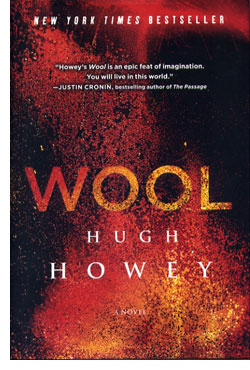 |
 Hugh Howey
Hugh Howey
Wool
Simon & Schuster
US Trade Hardcover First Edition
ISBN 978-1-476-73511-5
Publication Date: 03-12-2013
352 Pages; $24.99
Date Reviewed: 03-24-2013
Reviewed by: Rick Kleffel © 2013
Index:
Science Fiction
General Fiction
A self-published, online serial is one sort of reading experience, while a self-contained, mass-market hardcover is quite another. Each brings its own set of expectations. 'Wool' by Hugh Howey started out as the former, and now, thanks to Simon & Schuster is the latter. Given its inception, one might well have cause to worry that the seams will show, and while that is to a degree the case, it's really no problem whatsoever. 'Wool' boxes the reader into an enclosed, claustrophobic world, but opens up by giving readers characters whose explorations of that world we enjoy ever more with each page turned. Howey underplays every assumption we might make and manages to craft his own genre in the process.
'Wool' plays out in three acts that show some of the seams of its serial inception. As a reading experience in the hardcover novel, it feels like we are burrowing ever deeper into this world and it proves to be an effective method of immersing us in a story where readers know a lot more about what's going on than the characters. The first act gives us Holsten and his wife, both inhabitants of the Silo, an underground city that is all its those who live there have ever known. That's because what's above ground is deadly, even to the unlucky who are sent outside for cleaning in elaborate protective suits.
The second act gives us Mayor Jahns, an elderly woman who runs the Silo and the deputy, Marnes, who set out in search of Juliette, a woman who works at the very bottom of the Silo and whom Marnes thinks is a good candidate for the new Sheriff. They have to make the journey from top to bottom, one step at a time, to find her.
The vital strength of Howey's world is the cast of characters of which the world itself is a crucial member. Howey's Silo is a 1950's nightmare made real, full of clanking steel and grinding gears, most of which seem to be made to grind down those who live inside. There's an IT department that has its own best interests in mind, and a server farm that would have seemed rather quaint about twenty years ago. The overall effect is not futuristic, but like something from a Civil Defense Public Service announcement. The Silo is not a people-friendly place for the remnants of humanity to live.
Howey's humans; Holsten, Mayor Jahns, Marnes, Juliette and more than a few others, all have a worn-down feel as well. They ring true to anyone who has ever slogged through a forty hour week and felt only the strength to make it to the couch and sleep. But seeing the human connections that spark even in this dreary, dimly-lit world brings some real verve and warmth the the chilly world. Howey infuses our reading with the hopes born of readers who know pretty much everything the characters don't. He uses this tension to effectively drive the plot.
'Wool' offers a hard headed vision that revels in paradox. On one hand, we know from the get-go what's going on, and question why the characters don't. But we could be wrong, and Howey offers up a variety of twists and some great set-pieces to suggest how the Silo came to be. It does not take long for the world of the Silo to seem as real as the world in which you're reading about the Silo. By then Howey has you, and no matter what kind of reading experience you might have been expecting, what you get is a novel a new world that feels old and an old-fashioned-novel that works some very new territory.
Whether you like the world of the Silo or not, you're certainly not going to forget it. Every step you take, up or down, leads to a new level of your life, and while your confines may not be made of old, rusting steel, they are just as effective. You might choose to go outside; you can choose to go outside. And once that choice is made, you won't be able to return to the safety of your old world, ever.
|
 |




